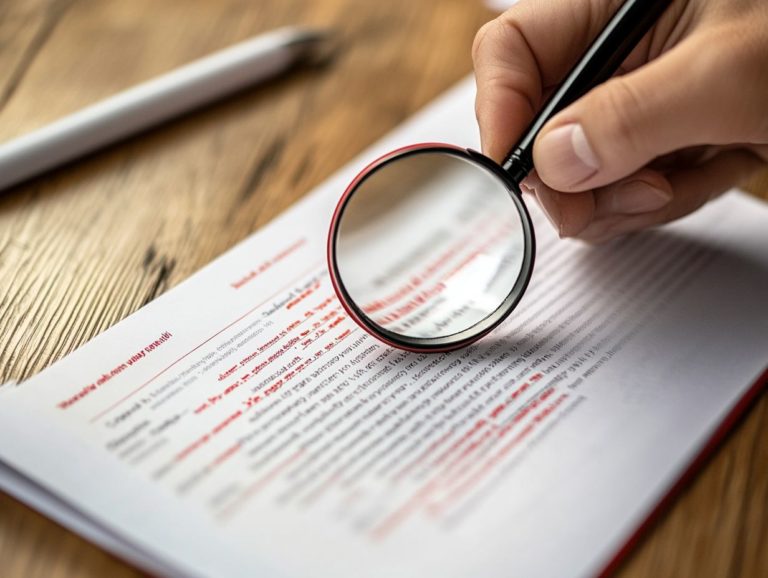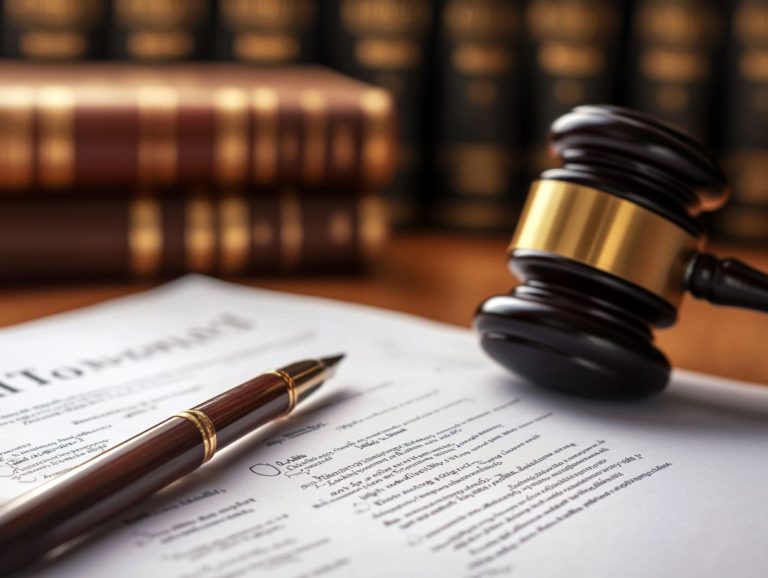Licensing Agreements for Artwork: Key Considerations
Navigating the intricate realm of artwork licensing may seem daunting. However, grasping the nuances of licensing agreements is essential for artists, collectors, and businesses alike.
These agreements serve to safeguard the rights of creators while clearly outlining how their work may be utilized. From understanding critical components such as scope and payment terms to addressing prevalent challenges like creative work protection, this article equips you with the insights necessary for effective negotiations and drafting.
Delve into the key considerations that underscore the importance of licensing agreements in the art world.
Contents
- Key Takeaways:
- Understanding Licensing Agreements for Artwork
- Key Elements of a Licensing Agreement
- Common Issues and Challenges with Licensing Agreements
- Negotiating and Drafting a Licensing Agreement
- Frequently Asked Questions
- What is a licensing agreement for artwork?
- What are some key considerations when entering into a licensing agreement for artwork?
- What is the scope of a licensing agreement for artwork?
- How long do licensing agreements for artwork typically last?
- Are there any restrictions or limitations on the use of the artwork in a licensing agreement?
- What should I do if I want to terminate a licensing agreement for artwork?
Key Takeaways:

Licensing agreements are legal contracts that allow individuals or companies to use artwork for specific purposes, such as reproduction or distribution. These agreements protect artists and licensors, ensuring they receive fair compensation for their creative work. When negotiating and drafting a licensing agreement, carefully consider the scope of use, duration and territory, and payment terms. Also, protect your creative work and seek legal guidance.
Understanding Licensing Agreements for Artwork
Grasping the intricacies of licensing agreements for artwork is essential for visual artists. It helps safeguard their creative endeavors while optimizing income potential.
A thoughtfully crafted licensing agreement establishes a legal framework that clearly explains what both parties can and cannot do. This allows you to maintain control over your creative work as you navigate various licensing opportunities.
By employing effective licensing strategies, you can skillfully showcase your artwork across diverse markets. This generates revenue through royalties and licensing fees. Understanding this process is crucial for boosting both your creativity and your income!
What is a Licensing Agreement?
A licensing agreement is a legal document that enables you to use someone else’s creative work under specific conditions, particularly in artwork licensing. This agreement meticulously outlines the terms governing how the artwork can be utilized, including restrictions on reproduction, distribution, and modifications, all aimed at protecting the artist s copyright.
For visual artists, such a document is critical. It establishes a clear framework for how their creations can be used while ensuring their unique works are safeguarded.
Key elements of these agreements often encompass:
- The scope of usage whether for commercial or non-commercial purposes
- Payment terms
- Duration of the license
- Territorial rights
For instance, a commercial license permits you to use artwork for profit-driven endeavors. In contrast, a non-commercial license might restrict usage to educational or personal contexts. These distinctions carry substantial weight when it comes to copyright protection and the artist’s rights, influencing potential income and exposure opportunities.
Therefore, it s crucial for artists to thoughtfully consider the type of license they pursue.
Why is it Important for Artwork?
Licensing agreements are essential for you as a visual artist. They offer a structured avenue to monetize your creative works while protecting your copyright and intellectual property rights.
These agreements also help you earn money through royalties and licensing fees. They ensure that your artwork is utilized in ways that resonate with your artistic vision and market appeal.
Through licensing, you can reach new audiences and enhance your visibility, all while maintaining control over how your work is represented. Partnering with brands or companies not only secures your financial stability but also enriches your portfolio through exciting collaborations.
Picture your art lighting up consumer products like home decor or apparel this could be your next big break! This strategy diversifies your revenue streams and solidifies your brand presence, paving the way for further opportunities in exhibitions or commissioned works.
Ready to dive into the world of licensing? Start exploring your options today!
Key Elements of a Licensing Agreement
The key elements of a licensing agreement are essential for defining the relationship between you, the artist, and the licensee. They ensure clarity and mutual understanding regarding the use of your artwork.
Typically, these elements include the scope of use, detailing how your artwork may be used, along with the duration and territory of the license. Together, they clearly outline the rights granted to the licensee, safeguarding both parties’ interests.
Scope of Use

The scope of use in a licensing agreement outlines how you can use the artwork, specifying whether your usage is commercial or non-commercial. This section is crucial as it sets the parameters for how the artwork can be reproduced, distributed, or modified.
A well-defined scope not only protects the artist’s rights but also clarifies the expectations for both parties. For instance, if you decide to license artwork for product packaging, it s vital to specify the duration and geographic area of use to avoid unauthorized reproductions.
Understanding the differences between limited and open editions can significantly influence an artist s revenue streams. Limited editions can yield higher prices, while open editions allow for broader distribution.
By understanding the implications of various types of licenses, you can foster a mutually beneficial relationship that honors creative integrity while promoting financial growth for both the artist and yourself.
Duration and Territory
Duration and territory are critical components of any licensing agreement, defining how long you can use the artwork and in which geographical regions. These elements protect the artist’s copyright by defining the time frame and locations where their creative work can be used.
Licensing can last from one to five years, depending on the type of artwork and market needs, while territories can specify local, national, or even international scopes.
When an artist grants a license that restricts usage to a particular region, they preserve control over other markets, opening the door for negotiating separate agreements that could generate additional income. As a licensee, understanding the timeline and area of usage enables you to craft more effective promotional strategies.
In the end, mastering these agreements allows both artists and licensees to achieve their objectives while honoring the creator’s rights.
Royalties and Payment Terms
Royalties and payment terms are pivotal components of any licensing agreement, detailing how and when you, as the artist, will be compensated for the use of your artwork.
These terms can outline a percentage of sales or fixed licensing fees, playing a significant role in your revenue generation. Understanding these structures is essential, as they can vary widely depending on the project and your negotiating leverage.
For example, some agreements might include advance payments, performance milestones, or even retroactive royalties tied to sales thresholds, creating potential for increased earnings.
Clear communication about these details is vital; it helps prevent disputes and ensures you receive fair compensation for your contributions. Well-defined terms enhance your ability to plan financially, offering a sense of security as you navigate your creative career.
Common Issues and Challenges with Licensing Agreements
Licensing agreements are essential, yet they often bring forth a range of challenges that you must skillfully navigate to protect your rights and ensure compliance.
A significant concern lies in protecting your intellectual property (the creative work you own); ambiguous terms can lead to unauthorized use or copyright infringement, jeopardizing your control over your creative work.
Stay alert to protect your rights! Understanding these agreements is crucial to maintain the integrity of your artistry.
Protecting Intellectual Property
Protecting your intellectual property is essential when entering into written agreements that allow others to use your artwork. It ensures that your creative works aren t misused or exploited without your consent.
To safeguard your rights and maintain the integrity of your artwork, effective copyright protection mechanisms must be included in the agreement. Register your works with the appropriate copyright office for solid legal backing that strengthens your claims.
Outline clear usage terms in the licensing agreement. Specify how, where, and for what duration your artwork can be used. A strong legal framework empowers you to fight for your rights!
By educating yourself about your rights and leveraging these legal safeguards, you can better protect your creative expressions and ensure that your contributions are honored in the marketplace.
Enforcing the Agreement

Enforcing licensing agreements is essential for ensuring compliance with the terms set forth, especially regarding your intellectual property rights. Grasp the legal framework that governs these agreements to address any breaches or disputes that may arise during the licensing process.
Take proactive steps like keeping meticulous records of all transactions and communications related to your licenses. Engaging with licensing agents or legal professionals can provide invaluable guidance.
These experts are well-versed in the nuances of the law and can assist you in drafting robust agreements. If you encounter non-compliance, explore legal avenues such as mediation or litigation to address breaches and seek remedies.
Ultimately, understanding enforcement mechanisms and available support will ensure that you can effectively protect your creative works.
Negotiating and Drafting a Licensing Agreement
Negotiating and drafting a licensing agreement is a crucial process that demands careful consideration and strategic planning. Achieve a successful outcome for both you, the artist, and the licensee.
Use effective negotiation techniques to clearly articulate your needs and establish terms that safeguard your rights while maximizing your potential revenue streams.
Tips for a Successful Agreement
To secure a successful licensing agreement, keep a few key tips in mind! Start by defining the scope of use and understanding royalty structures. Set realistic expectations regarding the duration and territory of the license.
Prepare by researching market standards to negotiate confidently. Ensure clarity in the terms, as vague language can lead to misunderstandings and potential disputes later on.
Prioritize the protection of your intellectual property. Include specific clauses that safeguard your rights while detailing how your work can be utilized.
By clearly communicating your expectations during the drafting phase, foster a balanced agreement that maximizes revenue potential without compromising your artistic integrity.
Working with Legal Professionals
Working with legal professionals can make navigating licensing agreements easier. Their insights into copyright law help protect your rights.
They assist in crafting agreements that are enforceable and beneficial for you. Understanding potential pitfalls and benefits associated with different licensing options is crucial.
For instance, when negotiating a deal for your original music in film or television, having a legal professional can help you determine fair compensation, clarify usage rights, and outline terms clearly ultimately preventing future disputes.
If your work is misused or not credited, legal guidance is essential for enforcing your rights and seeking the remedies you deserve. You’ll feel confident knowing your creative work is protected while you focus on your artistic endeavors.
Frequently Asked Questions
What is a licensing agreement for artwork?

A licensing agreement for artwork is a legally binding contract between the owner of the artwork (licensor) and another party (licensee) that grants the licensee the right to use the artwork for specific purposes, typically in exchange for a fee.
What are some key considerations when entering into a licensing agreement for artwork?
- Scope of the license
- Duration of the agreement
- Payment terms
- Restrictions or limitations on usage
What is the scope of a licensing agreement for artwork?
The scope refers to the specific rights and permissions granted to the licensee. This can include the right to reproduce, distribute, publicly display, or create derivative works of the artwork.
How long do licensing agreements for artwork typically last?
The duration varies, but they typically last for a set period, such as one to three years. The duration should be clearly specified in the agreement.
Are there any restrictions or limitations on the use of the artwork in a licensing agreement?
Yes, there may be restrictions on how the artwork can be used, including limitations on medium, geographic restrictions, or alterations to the artwork.
What should I do if I want to terminate a licensing agreement for artwork?
If you wish to terminate an agreement, review the terms to see if termination provisions exist. If not, you may need to negotiate with the other party or seek legal advice.
If you have more questions about licensing agreements, consider seeking legal assistance!






